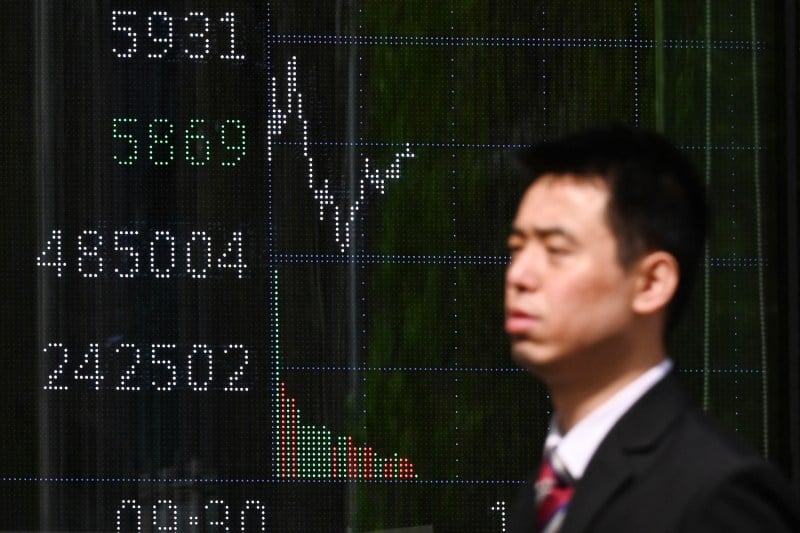U.S. Tariffs on China Trigger Retaliatory Measures

U.S. Tariffs on China Trigger Retaliatory Measures
Dozens of countries are taking diplomatic steps to address the White House’s trade war. China is not one of them.
A man walks past a screen showing Chinese stock market movements at a securities company in Beijing on April 8. Greg Baker/AFP via Getty Images
The world is bracing for U.S. President Donald Trump’s sweeping tariffs to go into effect on Wednesday. Nearly all of the United States’ trading partners will be affected, from uninhabited islands to Washington’s biggest adversaries, and global stock markets are preparing for the potentially catastrophic effects the duties are expected to inflict on global supply chains.
U.S. Treasury Secretary Scott Bessent said perhaps as many as 70 countries have requested negotiations with Trump to discuss reducing or eliminating the tariffs—with varying degrees of success. However, China stands out as the only major economy to counter Trump with its own retaliatory duties so far.
The world is bracing for U.S. President Donald Trump’s sweeping tariffs to go into effect on Wednesday. Nearly all of the United States’ trading partners will be affected, from uninhabited islands to Washington’s biggest adversaries, and global stock markets are preparing for the potentially catastrophic effects the duties are expected to inflict on global supply chains.
U.S. Treasury Secretary Scott Bessent said perhaps as many as 70 countries have requested negotiations with Trump to discuss reducing or eliminating the tariffs—with varying degrees of success. However, China stands out as the only major economy to counter Trump with its own retaliatory duties so far.
Last Friday, Beijing announced that it would match the 34 percent tariff rate that Trump imposed on China and hit the United States with a slew of other countermeasures. That defiance angered Trump. On Truth Social on Monday, he wrote that the United States would impose additional 50 percent tariffs on Beijing if it failed to repeal its 34 percent countertariffs by Tuesday.
The Chinese Commerce Ministry fired back, saying that “the U.S. threat to escalate tariffs is doubly erroneous” and that China would once again “take firm countermeasures to safeguard its legitimate rights and interests” in response. As of noon on Tuesday, with China not backing down, the White House announced that the new 50 percent tariff would go into effect on Wednesday.
That will bring the average tariff on Chinese imports to an astronomical 126 percent, with Trump himself having added 104 percent over four rounds of tariffs in just the past three months on top of tariffs that predated his second term.
Read more in today’s World Brief: China Remains Defiant in Face of New Trump Tariffs.
This post is part of FP’s ongoing coverage of the Trump administration. Follow along here.
Alexandra Sharp is the World Brief writer at Foreign Policy. X: @AlexandraSSharp
Lili Pike is a reporter at Foreign Policy. X: @lili_pike
More from Foreign Policy
-

American flags are draped around tables and pipes in a small factory room as women work at sewing machines to produce them. Tariffs Can Actually Work—if Only Trump Understood How
Smart trade policy could help restore jobs, but the president’s carpet-bomb approach portends disaster.
-

Donald Trump looks up as he sits beside China’s President Xi Jinping during a tour of the Forbidden City in Beijing on Nov. 8, 2017. Asia Is Getting Dangerously Unbalanced
The Trump administration continues to create headlines, but the real story may be elsewhere.
-

Trump announces tariffs Trump’s Wanton Tariffs Will Shatter the World Economy
Economic warfare is also a test for U.S. democracy.
-

The Department of Education building in Washington, DC on March 24. Why Republicans Hate the Education Department
Broad popular support means that even Ronald Reagan failed at dismantling the agency.











Join the Conversation
Commenting on this and other recent articles is just one benefit of a Foreign Policy subscription.
Already a subscriber?
.
Subscribe
Subscribe
View Comments
Join the Conversation
Join the conversation on this and other recent Foreign Policy articles when you subscribe now.
Subscribe
Subscribe
Not your account?
View Comments
Join the Conversation
Please follow our comment guidelines, stay on topic, and be civil, courteous, and respectful of others’ beliefs.
Change your username |
Log out
Change your username:
CANCEL
Confirm your username to get started.
The default username below has been generated using the first name and last initial on your FP subscriber account. Usernames may be updated at any time and must not contain inappropriate or offensive language.